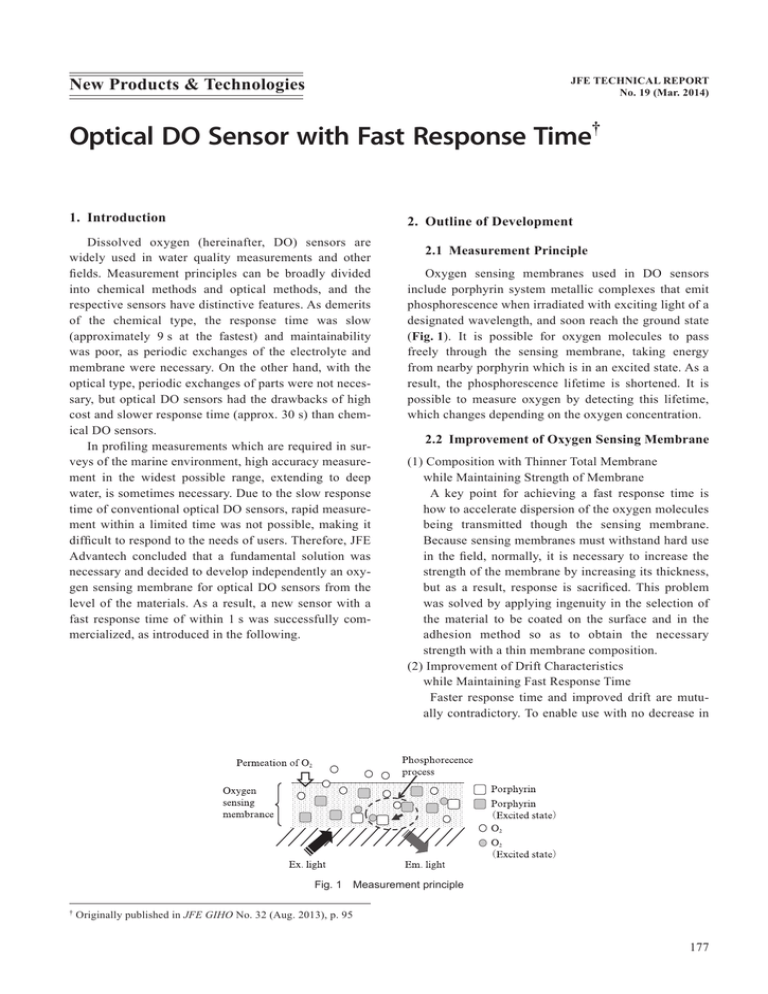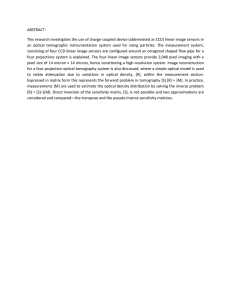Optical DO Sensor with Fast Response Time
advertisement

New Products & Technologies JFE TECHNICAL REPORT No. 19 (Mar. 2014) Optical DO Sensor with Fast Response Time† 1. Introduction 2. Outline of Development Dissolved oxygen (hereinafter, DO) sensors are widely used in water quality measurements and other fields. Measurement principles can be broadly divided into chemical methods and optical methods, and the respective sensors have distinctive features. As demerits of the chemical type, the response time was slow (approximately 9 s at the fastest) and maintainability was poor, as periodic exchanges of the electrolyte and membrane were necessary. On the other hand, with the optical type, periodic exchanges of parts were not necessary, but optical DO sensors had the drawbacks of high cost and slower response time (approx. 30 s) than chemical DO sensors. In profiling measurements which are required in surveys of the marine environment, high accuracy measurement in the widest possible range, extending to deep water, is sometimes necessary. Due to the slow response time of conventional optical DO sensors, rapid measurement within a limited time was not possible, making it difficult to respond to the needs of users. Therefore, JFE Advantech concluded that a fundamental solution was necessary and decided to develop independently an oxygen sensing membrane for optical DO sensors from the level of the materials. As a result, a new sensor with a fast response time of within 1 s was successfully commercialized, as introduced in the following. 2.1 Measurement Principle Oxygen sensing membranes used in DO sensors include porphyrin system metallic complexes that emit phosphorescence when irradiated with exciting light of a designated wavelength, and soon reach the ground state (Fig. 1). It is possible for oxygen molecules to pass freely through the sensing membrane, taking energy from nearby porphyrin which is in an excited state. As a result, the phosphorescence lifetime is shortened. It is possible to measure oxygen by detecting this lifetime, which changes depending on the oxygen concentration. 2.2 Improvement of Oxygen Sensing Membrane (1) Composition with Thinner Total Membrane while Maintaining Strength of Membrane A key point for achieving a fast response time is how to accelerate dispersion of the oxygen molecules being transmitted though the sensing membrane. Because sensing membranes must withstand hard use in the field, normally, it is necessary to increase the strength of the membrane by increasing its thickness, but as a result, response is sacrificed. This problem was solved by applying ingenuity in the selection of the material to be coated on the surface and in the adhesion method so as to obtain the necessary strength with a thin membrane composition. (2) Improvement of Drift Characteristics while Maintaining Fast Response Time Faster response time and improved drift are mutually contradictory. To enable use with no decrease in Fig. 1 Measurement principle † Originally published in JFE GIHO No. 32 (Aug. 2013), p. 95 177 Optical DO Sensor with Fast Response Time Fig. 2 Examples of products either type of performance, in addition to improving the macromolecular polymer, a deterioration inhibitor with good compatibility was selected and a new filmforming method was established. A fast response time of within 1 s was realized, satisfying the development target, and high evaluations were obtained in tests by leading research institutions, including the Meteorological Research Institute of the Japan Meteorological Agency, the Japan Agency for Marine-Earth Science and Technology, and others1). 3. Conclusion Optical DO sensors with fast response time have been installed in various water quality meters. At pres- 178 ent, the lineup of sensors includes more than 8 types. These devices are widely used by survey, testing, and research organizations in Japan and other countries. Examples of products are shown in Fig. 2. Reference 1) Uchuda, Hiroshi; Kawano, Takeshi; Wakita, Masahide; Kumamoto, Yuichiro; Nagasawa, Yashuhiro; Masumoto, Masakazu. Blue Earth ’10. 2010, p. 129–130. For Further Information, Please Contact: Ocean & River Instruments Div., JFE Advantech Fax: (81)78–997-8609 E-mail: ocean@jfe-advantech.co.jp Website: http://www.jfe-advantech.co.jp/eng/ JFE TECHNICAL REPORT No. 19 (Mar. 2014)
